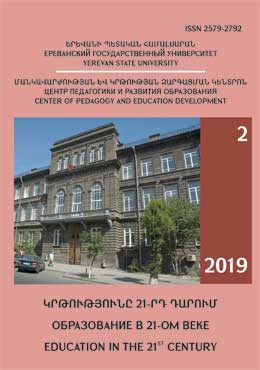MONITORING OF THE PHYSICAL CONDITION OF SCHOOLCHILDREN IN THE SYUNIK MARZ
DOI:
https://doi.org/10.46991/educ-21st-century.v2i2.10800Keywords:
monitoring, physical development, motor readiness, process of physical education, individual development, pedagogical testing.Abstract
The physical condition of schoolchildren: the level of physical development and motor readiness is one of the most important components of the physical perfection of a man. Therefore, the assessment of the level of schoolchildren’s physical condition is an integral and mandatory part of any physical education program and one of the criteria for determining the effectiveness of the physical education process in comprehensive school in our country. The analysis of the literary sources indicates a deterioration in physical condition of schoolchildren of different countries. A similar picture is typical for schoolchildren in Armenia.
The above emphasizes the importance and the need for systematic monitoring of the physical condition of schoolchildren of different ages and sexes, especially in remote and rural areas of our
country.
In this paper, we discuss data on the signs of the main gender characteristics and indicators of the physical condition of schoolchildren aged 6-17 years old, permanently living in the Syunik Marz. The signs of the body growth and weight as well as the indicators of movement speed, muscle strength, jumping ability and endurance in 1067 schoolchildren of both sexes have been studied.
As the result of the study, it was found that ontogenetic changes of the indicators of the physical condition are heterogeneous and uneven, which is explained by the laws of the growth and development of the body of schoolchildren of different ages.
The revealed patterns of age related signs of physical development and physical readiness of schoolchildren in the Syunik Marz can be used as an appropriate basis for developing relevant regulatory requirements and creating a system of tasks for the comprehensive and harmonious development of schoolchildren of both sexes, the development of appropriate regional assessment scales and physical education programs.
References
Օգտագործված գրականության ցանկ
Ղազարյան Ֆ. Գ., Մարդու ֆիզիկական վիճակի մոնիթորինգ, Երևան, 2007, 215 էջ:
Մկրտչյան Թ. Լ., Դպրոցականների շարժողական պատրաստվածության իրա¬կա-նացման մեթոդական պայմանները ֆիզիկական դաստիարակության գործընթա¬ցում. Թեկն. ատեն. սեղմագիր, Երևան, 2016, 22 էջ:
Круцевич Т.Ю., Современные подходы к организации системы физического воспитания школьников Украины //Материалы XXII международного конгресса. Тби¬лиси, 2018, с. 436-439.
Левитес Д.Г., Школьное обучение как инструмент педагогического насилия //“Педагогика”, 2018, N3, с. 38-43.
Саркисян С., Как здоровье, армянский подросток? “Новое время”, 2011, 29 сентября.
Шишова А.В., Персонификация медико-педагогического сопро¬вож¬дения обучаю-щихся с учетом гетерохронии их развития. Тезисы международной конференции. М., 2016, с. 121.
Meisner K., Telensy vychovy a vykopost zaki 16 az 18 letzi se zvlastnnm vzetelem k pozadavkum arawadu.-II Mezionarodnu Kongres. Praga: 1996, s. 112-114.
The Health of Youth Gross-National Suryey. WHO Regional Publication. European series. 1996, N69.
Downloads
Published
How to Cite
Issue
Section
License

This work is licensed under a Creative Commons Attribution-NonCommercial 4.0 International License.

